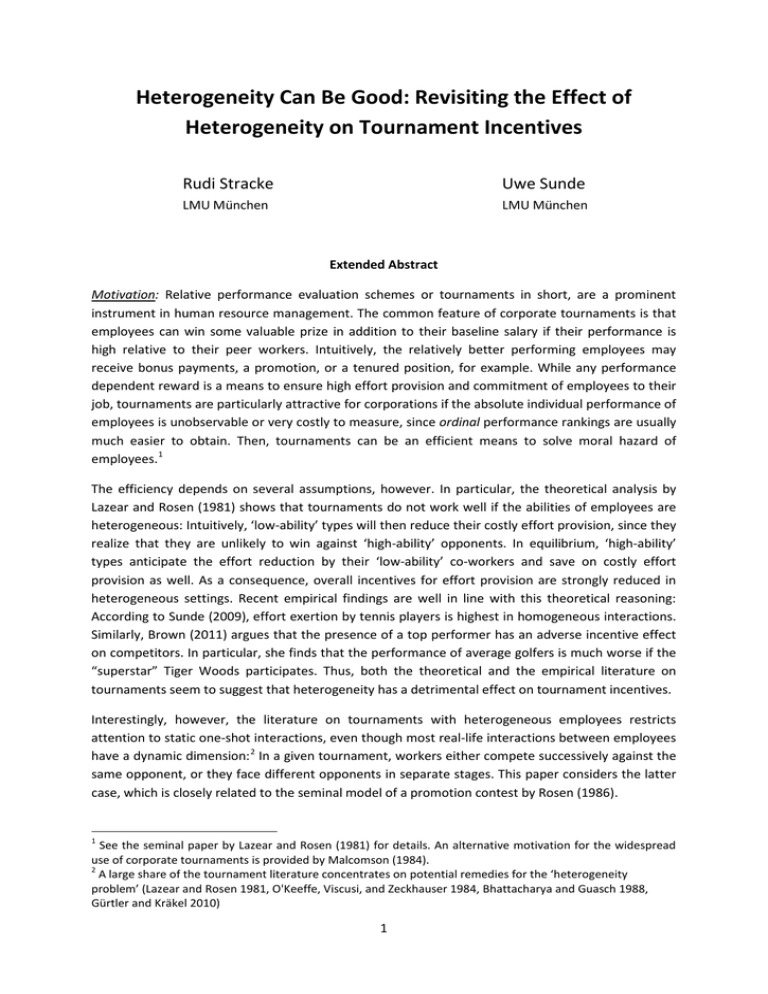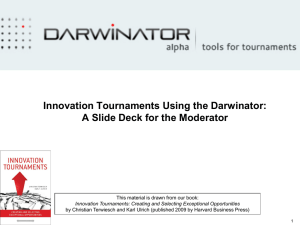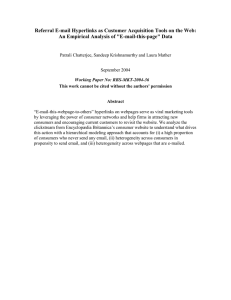Heterogeneity Can Be Good: Revisiting the Effect of Heterogeneity
advertisement

Heterogeneity Can Be Good: Revisiting the Effect of
Heterogeneity on Tournament Incentives
Rudi Stracke
Uwe Sunde
LMU München
LMU München
Extended Abstract
Motivation: Relative performance evaluation schemes or tournaments in short, are a prominent
instrument in human resource management. The common feature of corporate tournaments is that
employees can win some valuable prize in addition to their baseline salary if their performance is
high relative to their peer workers. Intuitively, the relatively better performing employees may
receive bonus payments, a promotion, or a tenured position, for example. While any performance
dependent reward is a means to ensure high effort provision and commitment of employees to their
job, tournaments are particularly attractive for corporations if the absolute individual performance of
employees is unobservable or very costly to measure, since ordinal performance rankings are usually
much easier to obtain. Then, tournaments can be an efficient means to solve moral hazard of
employees.1
The efficiency depends on several assumptions, however. In particular, the theoretical analysis by
Lazear and Rosen (1981) shows that tournaments do not work well if the abilities of employees are
heterogeneous: Intuitively, ‘low-ability’ types will then reduce their costly effort provision, since they
realize that they are unlikely to win against ‘high-ability’ opponents. In equilibrium, ‘high-ability’
types anticipate the effort reduction by their ‘low-ability’ co-workers and save on costly effort
provision as well. As a consequence, overall incentives for effort provision are strongly reduced in
heterogeneous settings. Recent empirical findings are well in line with this theoretical reasoning:
According to Sunde (2009), effort exertion by tennis players is highest in homogeneous interactions.
Similarly, Brown (2011) argues that the presence of a top performer has an adverse incentive effect
on competitors. In particular, she finds that the performance of average golfers is much worse if the
“superstar” Tiger Woods participates. Thus, both the theoretical and the empirical literature on
tournaments seem to suggest that heterogeneity has a detrimental effect on tournament incentives.
Interestingly, however, the literature on tournaments with heterogeneous employees restricts
attention to static one-shot interactions, even though most real-life interactions between employees
have a dynamic dimension: 2 In a given tournament, workers either compete successively against the
same opponent, or they face different opponents in separate stages. This paper considers the latter
case, which is closely related to the seminal model of a promotion contest by Rosen (1986).
1
See the seminal paper by Lazear and Rosen (1981) for details. An alternative motivation for the widespread
use of corporate tournaments is provided by Malcomson (1984).
2
A large share of the tournament literature concentrates on potential remedies for the ‘heterogeneity
problem’ (Lazear and Rosen 1981, O'Keeffe, Viscusi, and Zeckhauser 1984, Bhattacharya and Guasch 1988,
Gürtler and Kräkel 2010)
1
The model: We consider the simplest case of a multi-stage promotion contest with four risk-neutral
workers who compete for a promotion in two different stages, as depicted in Figure 1 below.
Figure 1: Structure of the Promotion Tournament
Workers have either ‘high’ or ‘low’ effort costs (𝒄𝑯 > 𝒄𝑳 ), i.e., workers are of two different types. .
Effort costs are an inverse measure for ability, i.e., ability is high if effort costs are low, and vice
versa. Types are assumed to be common knowledge. The principal hires 𝒏 ‘low-cost’ and 𝟒 − 𝒏 ‘highcost’ employees. Each worker i receives a type specific fixed wage 𝒘𝒊 when being hired. It is assumed
that the principal takes fixed wages as given, since they are determined on the labor market and
reflect the ability of a worker (𝒘𝑳 > 𝒘𝑯 ). In addition to the fixed (reservation) wage, the winner of
the tournament receives the prize B at the end of the tournament. 3 Assuming that one unit of effort
provision by workers translates into a one unit increase of the principal’s revenues, the optimization
problem of the principal reads
max
𝑛∈{0,1,2,3,4}
𝜑(𝑛) = 𝑛 ∗ [𝑥𝐿 (𝑛) − 𝑤𝐿 ] + (4 − 𝑛) ∗ [𝑥𝐻 (𝑛) − 𝑤𝐻 ] − 𝐵,
(1)
where 𝒙𝒊 (𝒏) is the expected equilibrium effort provision of a worker with effort cost 𝒄𝒊 in both
stages of a tournament with 𝒏 ‘low-cost’ and 𝟒 − 𝒏 ‘high-cost’ high cost workers. Thus, 𝒏 which
determines the number of ‘high-cost’ and ‘low-cost’ workers is the only choice variable of the
principal. To solve the model, we must first consider the optimization problem of workers in each of
the six possible configuration of the promotion tournament, which allows us to determine the
expected equilibrium effort provision for each case. 4 In the solution, we model each pairwise
interaction as a lottery contest à la Tullock (1980) with linear effort costs.
Results: Since it is a widely held belief that heterogeneity has a detrimental effect on tournament
incentives, we use the two homogeneous settings LLLL and HHHH as benchmarks and investigate
whether the effect of heterogeneity on profits is positive or negative. To allow for a meaningful
comparison, we assume that fixed wages are determined in such a way that the profits of
corporations which exclusively employ ‘low-cost’ or ‘high-cost’ workers, respectively, are identical.
This is the case if and only if
3
𝑤𝐿 = [𝑥𝐿 (4) − 𝑥𝐻 (4)] + 𝑤𝐻 .
(2)
The results do not change in qualitative terms if we allow for multiple prizes, i.e., if we introduce a runner-up
prize for the loser of the stage-2 interaction.
4
The six possible settings in stage 1 of the promotion tournament are LLLL (only ‘low-cost’), HHHH (only ‘highcost’), LHHH (one ‘low-cost’, three ‘high-cost’), LLLH (three ‘low-cost’, one ‘high-cost’), and LLHH or LHLH (equal
shares of each type with different seedings).
2
In other words, the competition between different corporations for workers of a certain type ensures
that wages perfectly compensate for absolute ability, i.e., relative wages compensate for the
capability advantage of ‘low-cost’ workers. In Figure 2, we normalize profits in the two homogeneous
configurations to zero and plot profits in the four heterogeneous configurations as a function of the
𝑐
degree of heterogeneity between types ( 𝐻 ).
𝑐
𝐿
Figure 2: Change of Profits in Heterogeneous Settings
The figure shows the incentive effect of heterogeneity is sometimes positive and sometimes
negative, depending on 𝒏 and the degree of heterogeneity between types. Most importantly,
however, profits are always maximized in a heterogeneous setting: 𝒏 = 𝟏 (LHHH) is optimal for low
heterogeneity (hard to see in the figure), while 𝒏 = 𝟐 (LLHH) is optimal for medium and high
heterogeneity. Thus, the results suggest that corporations may benefit from a heterogeneous
workforce in dynamic promotion tournaments, which is in contrast to the widely held belief that
heterogeneity is bad for incentives. Said differently, the effect of heterogeneity is often positive in
dynamic elimination contests, while this is not the case in static one-shot interactions. Intuitively,
heterogeneity does still have a detrimental effect on incentives within each one-shot interaction.
However, the dynamic effect of heterogeneity across interactions is positive. The reason is that
winning stage-1 becomes more attractive for ‘low-cost’ workers if there is a positive probability that
the stage-2 opponent has ‘high-costs’, and consequently ‘low-cost’ workers increase effort provision
in stage 1. As Figure 2 shows, it depends on the degree of heterogeneity and on 𝒏 which of the two
countervailing effects dominates.
Conclusion: The main finding of this paper is that the dynamic effect of heterogeneity across
interactions in a multi-stage promotion tournament is positive. As a consequence, the overall effect
of heterogeneity on incentives for effort provision is often positive in this tournament format, which
qualifies the widely held belief that heterogeneity between workers should be avoided in
tournament compensation schemes. Interestingly, empirical analyses of heterogeneity in
tournaments which find a detrimental effect either ignore the dynamic dimension in the playoff
stage (Sunde 2009), or they restrict attention to the effect of heterogeneity on ‘low-ability’ players,
ignoring potential equilibrium reactions of the superstar in a dynamic multi-stage contest (Brown
2011). Thus, the analysis in this paper does also deliver novel testable hypothesis for future empirical
work.
3
References
Bhattacharya, S., and J. L. Guasch (1988): ‘Heterogeneity, Tournaments, and Hierarchies’, Journal of
Political Economy.
Brown, J. (2011): ‘Quitters Never Win: The (Adverse) Incentive Effects of Competing with Superstars’,
Journal of Political Economy.
Gürtler, O., and M. Kräkel (2010): ‘Optimal Tournament Contracts for Heterogeneous Workers’,
Journal of Economic Behavior & Organization.
Lazear, E. P., and S. Rosen (1981): ‘Rank-Order Tournaments as Optimal Labor Contracts’, Journal of
Political Economy.
Malcomson, J. M. (1984): ‘Work Incentives, Hierarchy, and Internal Labor Markets’, Journal of
Political Economy.
O'Keeffe, M., W. K. Viscusi, and R. J. Zeckhauser (1984): ‘Economic Contests: Comparative Reward
Schemes’, Journal of Labor Economics.
Rosen, S. (1986): ‘Prizes and Incentives in Elimination Tournaments’, American Economic Review.
Sunde, U. (2009): ‘Heterogeneity and Performance in Tournaments: A Test for Incentive Effects using
Professional Tennis Data’, Applied Economics.
Tullock, G. (1980): ‘Efficient rent-seeking’, Toward a Theory of the Rent-Seeking Society. J.M.
Buchanan and R.D. Tollison and G. Tullock (Eds.).
4


